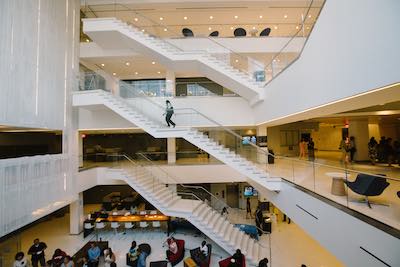
Looking back, Charles McNelis can trace the beginnings of his devotion to liberal studies to one great job he had when he was 11 years old.
“I was a newspaper delivery boy” in Yonkers, New York, during the Cold War years of the early 1980s “and I saw the headlines and was interested,” says McNelis, Pd.D., Faculty Director of the Master of Arts in Liberal Studies program at Georgetown University in Washington, D.C. “I realized there must be a backstory to all of this.”
A long backstory, as it turned out. To understand the Cold War and how the two superpowers had reached that point, McNelis started reading about World War II. That led him to World War I, the upheavals of the 19th century, then to the Enlightenment, the Reformation, the Renaissance, and the Middle Ages, and, eventually, back to the writers and philosophers of antiquity.
And that’s where liberal studies majors often start as well, with the Greek and Roman philosophers, whose principles undergird much of our beliefs today. One of those thinkers, the Roman politician and philosopher Cicero, created six precepts which, while reinterpreted to match the times, form the basis of the discipline. They are ethics, poetry, geometry (but not algebra, which had yet to be invented), oratory, politics, and music.
A Broad, Integrated View
The terms “liberal arts” and “liberal studies” are related and sometimes used interchangeably, but there is a distinction between them that Georgetown’s programs recognize. While both liberal arts and liberal studies emphasize the arts and humanities, liberal studies takes a broad, integrated view of these subjects. And while a liberal arts major might concentrate on a fairly narrow area of research, students in liberal studies seek to explore connections between these broad disciplines, even as they develop expertise in certain areas.
At Georgetown, students in the Master’s in Liberal Studies are required to take four core courses, which reflect the broad-based course of study that Cicero championed, only updated for modern times. These include: Norms and Ethics, Introduction to the Humanities, Introduction to the Social Sciences, and Science and Society.
While science is often seen as somehow separate from the liberal arts, such thinking would have seemed foreign to Cicero and, years later, to polymaths like Thomas Jefferson, whose vigorous intellectual pursuits included architecture, politics, the sciences, and the humanities.
Welders or Philosophers?
For years, there have been periodic backlashes to the liberal arts, most centered on the notion that they are impractical for college graduates seeking jobs in a technologically driven society. McNelis said this sentiment recently peaked around 2010, when the nation began feeling the full impact of the economic downturn, but one version of it appeared during the most recent presidential campaign.
“Welders make more money than philosophers,” Florida Senator Marco Rubio asserted during a Republican presidential debate. “We need more welders and less philosophers.”
Three years later, Rubio reversed himself after studying the Stoic philosophers, who have enjoyed something of a popular comeback: “We need both!” he tweeted. “Vocational training for workers & philosophers to make sense of the world.”
Skills for a Changing World
In fact, in our rapidly changing, global society, “making sense of the world” has become a marketable skill in itself. Studying the liberal arts helps students develop creativity, critical thinking, and communications skills—attributes employers say are essential in today’s fast-paced and collaborative workplaces.
“The jobs with highest demand for liberal arts majors are surprisingly diverse,” Rob Sentz, a labor market analyst, wrote in Forbes in 2016. “Intelligence analyst, client service specialist signals intelligence (SIGINT) analyst, business development manager, and project manager—compelling, high-demand careers.”
In fact, a study by the Association of American Colleges & Universities found that while liberal arts graduates tend to make less than their peers in applied subjects at the beginning of their careers, by the time they reach their peak earning years they earn slightly more.
Today, a liberal studies curriculum can especially benefit students with scientific backgrounds by nurturing much needed creativity as they step outside their usual concentrations, McNelis said. In the same way, liberal arts majors who acquire technical skills at some point in their careers are also taking advantage of the best of both worlds.
Learning ‘How to be Free’
For more than a generation, experts have predicted the demise of the liberal arts, and their popularity has fluctuated because of the economy and other factors. But they have endured and have always had their champions among policymakers.
For example, McNelis points to the 1946 Truman commission, which produced a report—“Higher Education for American Democracy”—that makes the case for liberal arts as effectively as if it were written today. This was the era of the Manhattan Project and the Cold War, when technological innovations were having a visible effect on American policy around the world.
Yet, while the report emphasizes technological skills, it is more interested in endorsing a well-rounded education for an increasingly diverse population.
Indeed, the report often sounds very much like the “values-based curriculum” that Georgetown’s liberal studies programs promote:
“If our colleges and universities are to graduate individuals who have learned how to be free, they will have to concern themselves with the development of self-discipline and self-reliance, of ethical principles and a guide for conduct, of sensitivity to injustice and inequality, of insight into human motives and aspirations, of discriminating appreciation of a wide range of human values, of the spirt of democratic compromise and cooperation.”
